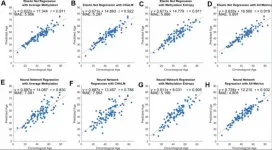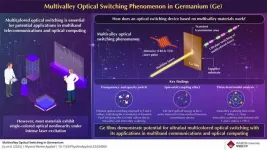(Press-News.org) A team of Lehigh University researchers has successfully predicted abnormal grain growth in simulated polycrystalline materials for the first time—a development that could lead to the creation of stronger, more reliable materials for high-stress environments, such as combustion engines. A paper describing their novel machine learning method was recently published in Nature Computational Materials.
“Using simulations, we were not only able to predict abnormal grain growth, but we were able to predict it far in advance of when that growth happens,” says Brian Y. Chen, an associate professor of computer science and engineering in Lehigh’s P.C. Rossin College of Engineering and Applied Science and a co-author of the study. “In 86 percent of the cases we observed, we were able to predict within the first 20 percent of the lifetime of that material whether a particular grain will become abnormal or not.”
When metals and ceramics are exposed to continuous heat—like the temperatures generated by rocket or airplane engines, for example—they can fail. Such materials are made of crystals, or grains, and when they’re heated, atoms can move, causing the crystals to grow or shrink. When a few grains grow abnormally large relative to their neighbors, the resulting change can alter the material’s properties. A material that previously had some flexibility, for instance, may become brittle.
“As we design materials, we’d like to be able to design them intentionally to avoid abnormal grain growth,” says Chen.
A smarter way to identify stable materials
To date, however, predicting abnormal grain growth has been a needle-in-a-haystack problem. There are countless combinations and concentrations that can go into the creation of any given alloy. Each of those metals must then be tested, which is expensive, time-consuming, and often impractical. The computational simulation developed by Chen’s team helps narrow down possibilities by quickly eliminating materials that are likely to develop abnormal grain growth.
“Our results are important because if you want to look at that big haystack of different materials, you don’t want to have to simulate each one for too long before you know whether or not abnormal grain growth is going to occur,” he says. “You want to simulate for as little time as possible, and then move on.”
The challenge is that abnormal grain growth is a rare event and, early on, the grains that will become abnormal look just like the others.
Unlocking hidden patterns with AI
To address this, the team developed a deep learning model that combined two techniques to analyze how grains evolve over time and interact with each other: A long short-term memory (LSTM) network modeled how the properties—or features—of the material would be evaluated and a graph-based convolutional network (GCRN) established relationships between the data that could then be used for prediction.
Initially, the researchers simply hoped to make successful predictions. They didn’t anticipate being able to make predictions so early.
“We thought that the data might be too noisy,” he says. “Maybe the properties we were looking at wouldn’t reveal very much about distant future abnormalities, or maybe the abnormality would only reveal itself just as it was about to happen, when it might be obvious even to the human eye. But we were surprised that we were actually able to make predictions so far in advance.”
Critical to that early detection was using their models to examine the grain’s characteristics over time before the abnormality occurred.
“A better way to think about grains becoming abnormal is to think about how they evolve in the time before they change,” he says. “So at 10 million time steps before abnormality, for example, they have certain properties that might differ from those they had at 40 million time steps.”
The team aligned each simulation at the point in time where the grain became abnormal, and worked backward examining its evolving properties. By identifying consistent trends in these properties, they were able to accurately predict which grains would become abnormal.
“If you look at the grains in terms of how much time before they transition, you can see shared trends that are useful for prediction,” he says.
In this project, Chen and his team conducted simulations of realistic materials. The next phase is to apply the approach to images of real materials and see if they can still accurately predict the future. The ultimate goal, says Chen, is to identify materials that are highly stable and can maintain their physical properties under a wide range of high-temperature, high-stress conditions. Such materials could allow engines and engine parts to run at higher temperatures for longer before failure.
The team also sees the potential of their novel machine learning method to predict other rare events, both within and beyond the field of materials science, thanks to its ability to identify warning signs in complex systems. For example, it could potentially help predict phase changes in materials, mutations leading to dangerous pathogens, or sudden shifts in atmospheric conditions.
“This work opens up an exciting new possibility for material scientists to ‘look into the future’ to predict the future evolution of material structures in ways that were never possible before,” says Martin Harmer, Lehigh’s Alcoa Foundation Professor of Materials Science and Engineering, Emeritus; director of the Nano/Human Interface Presidential Research Initiative; and co-author of the paper. “It will have a major impact in designing reliable materials for defense, aerospace and commercial applications.”
Research Team and Funding
Computer science and engineering PhD student Houliang Zhou and MS student Benjamin Zalatan co-authored the paper (npj Comput Mater 11, 82 (2025)) along with Chen, Harmer, and Joan Stanescu, visiting scholar in Lehigh’s Nano | Human Interfaces (NHI) Presidential Initiative; Jeffrey M. Rickman, Class of ’61 Professor of Materials Science and Engineering; Lifang He, an associate professor of computer science and engineering; and Lehigh alum Christopher J. Marvel ’12 ’16 PhD, an assistant professor of mechanical engineering at Louisiana State University.
This work was supported in part by the National Science Foundation, the Army Research Office, the Army Research Laboratory Lightweight High Entropy Alloy Design (LHEAD) Project, and the Lehigh University Presidential NHI Initiative.
Related figures and videos of the simulation (see Supplementary Information) are available via the Open Access article in npj Computational Materials.
Related Links
npj Computational Materials: "Learning to predict rare events: the case of abnormal grain growth"
Rossin College Faculty Profile: Brian Y. Chen
Lehigh NHI Presidential Initiative: Martin Harmer
Lehigh NHI Presidential Initiative: Joan Stanescu
Rossin College Faculty Profile: Jeffrey M. Rickman
Rossin College Faculty Profile: Lifang He
Louisiana State University: Christopher Marvel END
Novel machine learning model can predict material failure before it happens
Lehigh University team develops breakthrough approach to identify early warning signs of abnormal grain growth, paving the way for stronger, more resilient metals and ceramics used in aerospace, manufacturing, and beyond
2025-04-16
ELSE PRESS RELEASES FROM THIS DATE:
Hereditary Alzheimer’s: Blood marker for defective neuronal connections rises early
2025-04-16
Individuals with a genetic predisposition to Alzheimer’s disease show altered blood levels indicating damaged neuronal contacts as early as 11 years before the expected onset of dementia symptoms. This is evident in the levels of the protein “beta-synuclein”. An international team, including researchers from DZNE, Ulm University Hospital and University Medicine Halle report these findings in the journal “Alzheimer’s & Dementia”. The biomarker studied here could potentially help to detect neurodegeneration at an early stage and thus ...
Nature-based activity is effective therapy for anxiety and depression, study shows
2025-04-16
Researchers evaluating a nature-based programme of activities for patients with mild to moderate mental health conditions have shown that improvements in mood and anxiety levels can be seen in as little as 12 weeks.
As part of the UK government’s commitment to transform mental health services, seven ‘test and learn’ green social prescribing sites were identified across England, which included a programme in Humber and North Yorkshire - the first of the seven sites to publish results from the national programme.
Green social prescribing is a practice whereby a healthcare professional refers a patient to community-based nature activities ...
New genomics tool accelerates biomedical breakthroughs
2025-04-16
A University of Virginia School of Medicine scientist and collaborators have developed a much-needed new tool to increase the efficiency of genomic research and accelerate the development of new ways to improve human health.
UVA researcher Nathan Sheffield, PhD, has spent four years developing a new data standard to ensure that scientists are comparing apples to apples when doing genomic analysis. This type of analysis helps researchers understand the operating instructions for our cells and see how those instructions are carried out. The resulting insights help us understand the workings of both healthy cells and unhealthy ones, pointing us to new ways to treat and prevent disease.
Genomics ...
DNA methylation entropy: A new way to track and predict aging
2025-04-16
“We find that epigenetic clocks based on the entropy of methylation states predict chronological age with similar accuracy as common approaches that are based on methylation levels of individual cytosines.”
BUFFALO, NY — April 16, 2025 — A new research paper was published in Aging (Aging-US) Volume 17, Issue 3, on March 12, 2025, titled “DNA methylation entropy is a biomarker for aging.”
Researchers Jonathan Chan, Liudmilla Rubbi, and Matteo Pellegrini from the University of California, Los Angeles, led a study that discovered a new way to measure changes in DNA that can help predict a person’s ...
Mount Sinai Fuster Heart Hospital recognized by Press Ganey for patient experience excellence
2025-04-16
The Mount Sinai Fuster Heart Hospital’s cardiology faculty practice has received the 2024 Human Experience Pinnacle of Excellence Award® from Press Ganey, one of the nation’s leading patient experience organizations.
The faculty practice is located at The Mount Sinai Hospital and has several physicians with top expertise in cardiovascular care. It is one of 10 heart centers across the country, and the only one in New York, to receive this prestigious award placing it on the leading ...
Nurturing now, thriving later: The lasting power of affectionate mothering
2025-04-16
Affectionate mothering in childhood may have a lasting impact on important personality traits, potentially influencing life outcomes such as educational achievement, economic success, and health and well-being, according to research published by the American Psychological Association. The findings suggest that positive maternal parenting could foster important traits such as openness, conscientiousness and agreeableness.
“Personality traits are strong predictors of important life outcomes, from academic and career success to health and well-being,” ...
A step toward harnessing clean energy from falling rainwater
2025-04-16
When two materials come into contact, charged entities on their surfaces get a little nudge. This is how rubbing a balloon on the skin creates static electricity. Likewise, water flowing over some surfaces can gain or lose charge. Now, researchers reporting in ACS Central Science have harnessed the phenomenon to generate electricity from rain-like droplets moving through a tube. They demonstrate a new kind of flow that makes enough power to light 12 LEDs.
“Water that falls through a vertical tube generates a substantial amount of electricity by using a specific pattern of water flow: plug flow,” says Siowling Soh, the study’s corresponding ...
Term or permanent life insurance? A new study offers guidance
2025-04-16
COLUMBUS, Ohio – A new study offers clarity on one of the most common questions asked of financial professionals: Is term or permanent life insurance right for me?
Researchers at The Ohio State University conducted a study of how different life insurance product types were related to whether households had adequate financial resources if an income earner died.
They didn’t compare permanent and term life insurance directly, but they calculated how likely households with different life ...
Ultrafast multivalley optical switching in germanium for high-speed computing and communications
2025-04-16
Opaque materials can transmit light when excited by a high-intensity laser beam. This process, known as optical bleaching, induces a nonlinear effect that temporarily alters the properties of a material. Remarkably, when the laser is switched on and off at ultrahigh speeds, the effect can be dynamically controlled, opening new possibilities for advanced optical technologies.
Multicolored optical switching is an important phenomenon with potential applications in fields such as telecommunications and optical computing. However, most materials typically exhibit single-color optical nonlinearity under intense laser illumination, ...
Simulating protein structures involved in memory formation
2025-04-16
Our brain’s remarkable ability to form and store memories has long fascinated scientists, yet most of the microscopic mechanisms behind memory and learning processes remain a mystery. Recent research points to the importance of biochemical reactions occurring at postsynaptic densities—specialized areas where neurons connect and communicate. These tiny junctions between brain cells are now thought to be crucial sites where proteins need to organize in specific ways to facilitate learning and memory formation.
More specifically, a 2021 study revealed that memory-related proteins can bind together to form droplet-like structures ...
LAST 30 PRESS RELEASES:
New study overturns long-held model of how plants coordinate immune responses.
New AI model predicts disease risk while you sleep
Scientists discover molecular ‘reshuffle’ and crack an 80-year-old conundrum
How stressors during pregnancy impact the developing fetal brain
Electrons lag behind the nucleus
From fungi to brain cells: one scientist's winding path reveals how epigenomics shapes neural destiny
Schizophrenia and osteoporosis share 195 genetic loci, highlighting unexpected biological bridges between brain and bone
Schizophrenia-linked genetic variant renders key brain receptor completely unresponsive to both natural and therapeutic compounds
Innovative review reveals overlooked complexity in cellular energy sensor's dual roles in Alzheimer's disease
Autism research reframed: Why heterogeneity is the data, not the noise
Brazil's genetic treasure trove: supercentenarians reveal secrets of extreme human longevity
The (metabolic) cost of life
CFRI special issue call for papers: New Frontiers in Sustainable Finance
HKU Engineering scholar demonstrates the smallest all-printed infrared photodetectors to date
Precision empowerment for brain "eavesdropping": CAS team develops triple-electrode integrated functional electrode for simultaneous monitoring of neural signals and chemical transmitters during sleep
Single-capillary endothelial dysfunction resolved by optoacoustic mesoscopy
HKU three research projects named among ‘Top 10 Innovation & Technology News in Hong Kong 2025’ showcasing excellence in research and technology transfer
NLRSeek: A reannotation-based pipeline for mining missing NLR genes in sequenced genomes
A strand and whole genome duplication–aware collinear gene identification tool
Light storage in light cages: A revolutionary approach to on-chip quantum memories
Point spread function decoupling in computational fluorescence microscopy
BacPhase: Long-insert paired-end sequencing for bin marker construction and genome phasing
GmWOX1 regulates the mediolateral polarity of compound leaves in soybean
ChargeFabrica: An open-source simulation tool that aims to accelerate search for high performance perovskite solar cells
High levels of ADAR overexpression induce abundant and stochastic off-target RNA editing in rice protoplasts
On-demand upgraded recycling of polyethylene and construction of sustainable multifunctional materials based on the "LEGO" strategy
New "Stomata in-sight" system allows scientists to watch plants breathe in real-time
Anorexia nervosa may result in long-term skeletal muscle impairment
Narrative-based performance reviews deemed fairest by employees
New insights reveal how advanced oxidation can tackle emerging water pollutants
[Press-News.org] Novel machine learning model can predict material failure before it happensLehigh University team develops breakthrough approach to identify early warning signs of abnormal grain growth, paving the way for stronger, more resilient metals and ceramics used in aerospace, manufacturing, and beyond






